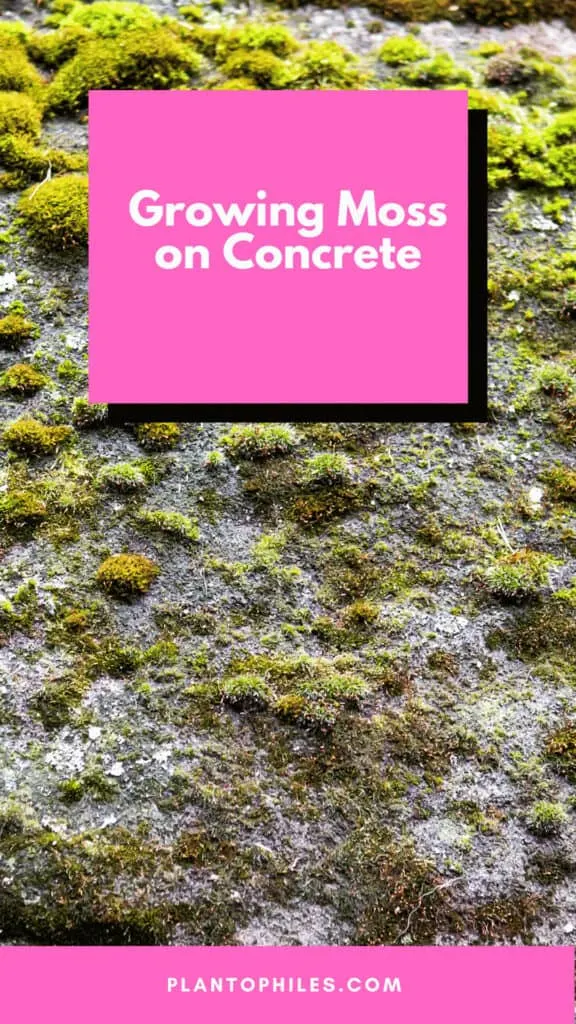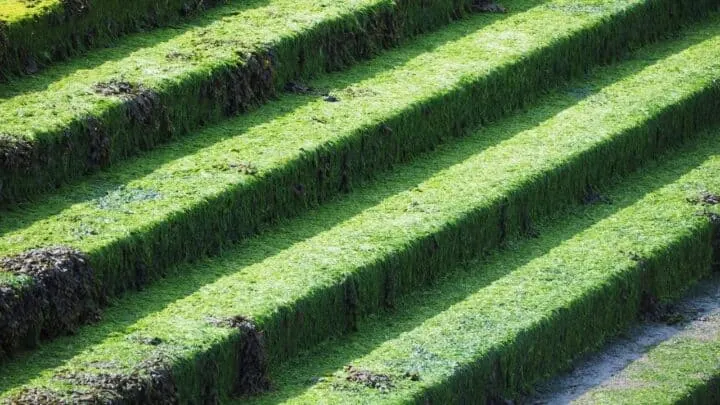A moss-covered surface’s soft, dainty look adds a fairytale aesthetic to any outdoor area.
Growing moss over ugly or bland surfaces is a fantastic and economical way to upgrade the look of your patio, terrace, or garden.
You cultivate this fuzzy green plant on concrete surfaces and can even create striking moss wall art by shaping the direction of your moss’s growth into patterns or images.
This begs the question, how do you actually grow moss on concrete?
Table of Contents
How to grow moss on concrete
To grow moss on concrete, start by making a batch of slurry by combining a dairy product and shredded moss. Then, use a paintbrush to apply the slurry liberally to your concrete surface. Mist the slurry layer regularly while taking care not to soak it. Expect to see the most growth within six weeks.

Growing moss on concrete — Required tools
| Tool | Purpose |
|---|---|
| Starter Moss | The type of moss you wish to grow, used to make slurry |
| Dairy Product | To mix with moss for slurry (yogurt, condensed milk, buttermilk) |
| Sugar | To add to slurry |
| Blender | For making slurry |
| Mister | For misting slurry |
| Thick Paintbrush | For applying slurry |
| Water | For misting and adjusting slurry consistency |
| Concrete Surface | Surface for moss growth |
To grow moss on concrete, you will need a patch of the moss variety you want to propagate, a dairy product such as yogurt, condensed milk or buttermilk, sugar, a blender, a mister, a thick paintbrush, water, and of course a concrete surface to grow your moss on.
Before exploring the specifics of making moss slurry, let’s discuss which type of moss is best suited for growing on concrete.
The best type of moss to grow on concrete
The best type of moss to grow on concrete can depend on several factors including climate, moisture availability, and the specific look you’re going for.
However, some commonly recommended types of moss for growing on concrete are:
- Springy Turf Moss (Rhytidiadelphus squarrosus): This is a common garden moss that’s relatively easy to grow and has a lush, green appearance.
- Spoon Leaved Moss (Bryoandersonia illecebra): This moss is well-suited for rock and concrete surfaces and has a unique spoon-like leaf structure.
- Pincushion Moss (Leucobryum glaucum): This type of moss forms cushion-like clumps and is very low-maintenance.
- American Tree Moss (Climacium americanum): Although the name suggests it grows on trees, it can also be used to grow on concrete and has a tall, tree-like structure for a moss.
- Fern Moss (Thuidium delicatulum): This moss has a fern-like structure and is another one that is relatively easy to grow.
- Silver Moss (Bryum argenteum): This is another hardy moss that can grow well on hard surfaces like concrete.
How to make moss slurry
To make moss slurry, add 2 cups of fresh moss to a blender to create your moss slurry. Add two to three cups of a wet dairy product, preferably buttermilk or unsweetened yogurt. You can also use condensed milk if you prefer. Add a teaspoon of sugar to the mixture. Blend the ingredients.
If your mixture is too thick, add water until your slurry is spreadable. If it is too thin and watery, supplement it with moss.
The slurry now needs to develop moss spores. For this, it should be left to sit for two days.
Do not refrigerate the mixture. Your slurry will only develop moss spores if kept at room temperature.
Before making your slurry, you must decide which moss variety you want to cultivate. You will be spoiled for choice, as there are 12,000 moss species in the world!
Some of the most famous varieties grown in gardens and on rock and concrete surfaces include Springy Turf Moss, Spoon Leaved Moss, Pincushion Moss, and American Tree Moss.
Most garden moss varieties require very similar care so that you can grow almost any variety on concrete.
How to cultivate moss on concrete
Identify where you want to grow your moss because how many batches of slurry you make depends on how much surface you need to cover.
You can choose to grow your moss somewhere smaller, like a walled garden border, or you can set out to create a whole living moss wall.
Once you have allowed your slurry to sit for two days, you can spread it onto your concrete surface using a thick paintbrush.
As soon as you have applied the slurry evenly, you will want to mist it using your misting bottle. For best results, use filtered water or collected rainwater.
Read up on the best water for houseplants to understand why using filtered or distilled water rather than tap water is beneficial to dampen your moss slurry.
Be careful not to overwater your moss slurry, as giving it too much water may wash away the spores in the mixture, rendering your slurry useless.
That said, you do want to continue to mist your slurry regularly.
Aim to keep it gently moist at all times.
Once you begin to see moss growth, which can take up to six weeks, you can slightly increase the amount of water you use.
Do not be alarmed if you initially see signs of mold. After all, you are fermenting a dairy product! The mold will disappear within the first six weeks after applying the slurry.
How to care for moss growing on concrete
Once your moss exhibits signs of growth, you can care for it more or less like a grass lawn.
Spray it regularly with a hose and aim to keep it gently moist at all times.
Moss does not have roots or stems, so how to keep the moss alive can initially seem like a mystery. It is a bryophyte and, therefore, takes in sunlight and water through the spores on its leaves.
Moss acts like a sponge and retains water easily. It will propagate and spread itself! This is great because it means you hardly need to do anything to get your moss to grow.
Seed pods grow on its minuscule leaves and cause the moss patch to expand as new moss grows up.
Keep this in mind when deciding when to grow your moss. Do not cultivate it too close to a vegetable patch; you may wonder how to eliminate moss in garden beds.
Moss has hardly any issues staying alive. Many struggle to keep moss from growing on concrete, a great sign for anyone looking to encourage its growth.
Once you have moss, you can easily transplant it. One cool way to bring your garden aesthetic indoors is to create an art-like moss terrarium!
Creating moss designs on concrete
Another way to use your moss to create art is to make what is sometimes called “moss graffiti” by cultivating moss to grow into words, patterns, or shapes on concrete.
The process is essentially the same as covering an entire surface in moss. You will want to make your moss slurry using the formula given above and then leave it to sit for two days.
Once spores have begun to develop, you can paint them into the shape, design, or illustration you want your moss to grow into.
Your moss will grow where the slurry was applied, and within two months, you will have your very own personalized moss graffiti.

Daniel has been a plant enthusiast for over 20 years. He owns hundreds of houseplants and prepares for the chili growing seasons yearly with great anticipation. His favorite plants are plant species in the Araceae family, such as Monstera, Philodendron, and Anthurium. He also loves gardening and is growing hot peppers, tomatoes, and many more vegetables.


